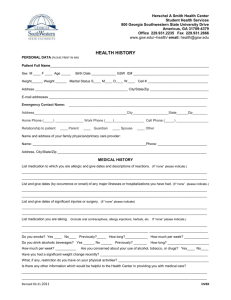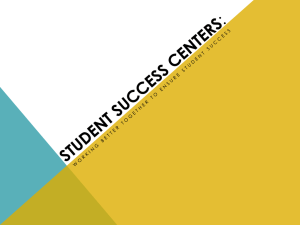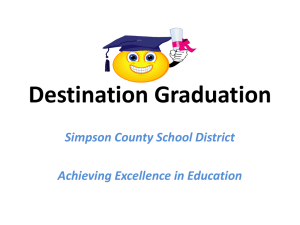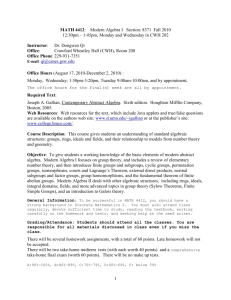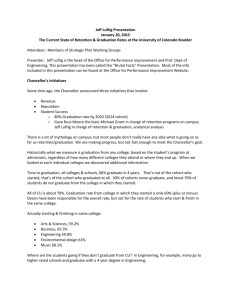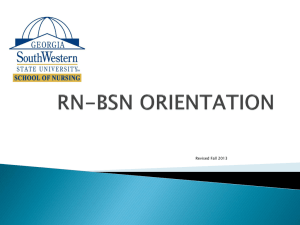Part I: Goals and Data Analysis - Georgia Southwestern State
advertisement
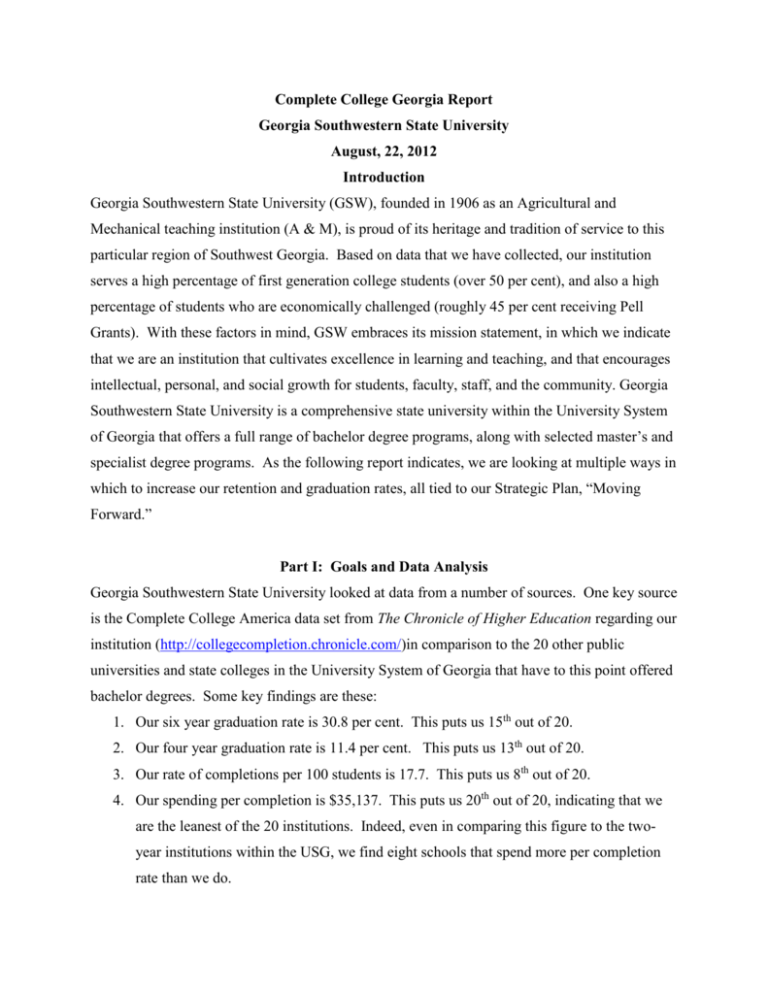
Complete College Georgia Report
Georgia Southwestern State University
August, 22, 2012
Introduction
Georgia Southwestern State University (GSW), founded in 1906 as an Agricultural and
Mechanical teaching institution (A & M), is proud of its heritage and tradition of service to this
particular region of Southwest Georgia. Based on data that we have collected, our institution
serves a high percentage of first generation college students (over 50 per cent), and also a high
percentage of students who are economically challenged (roughly 45 per cent receiving Pell
Grants). With these factors in mind, GSW embraces its mission statement, in which we indicate
that we are an institution that cultivates excellence in learning and teaching, and that encourages
intellectual, personal, and social growth for students, faculty, staff, and the community. Georgia
Southwestern State University is a comprehensive state university within the University System
of Georgia that offers a full range of bachelor degree programs, along with selected master’s and
specialist degree programs. As the following report indicates, we are looking at multiple ways in
which to increase our retention and graduation rates, all tied to our Strategic Plan, “Moving
Forward.”
Part I: Goals and Data Analysis
Georgia Southwestern State University looked at data from a number of sources. One key source
is the Complete College America data set from The Chronicle of Higher Education regarding our
institution (http://collegecompletion.chronicle.com/)in comparison to the 20 other public
universities and state colleges in the University System of Georgia that have to this point offered
bachelor degrees. Some key findings are these:
1. Our six year graduation rate is 30.8 per cent. This puts us 15th out of 20.
2. Our four year graduation rate is 11.4 per cent. This puts us 13th out of 20.
3. Our rate of completions per 100 students is 17.7. This puts us 8th out of 20.
4. Our spending per completion is $35,137. This puts us 20th out of 20, indicating that we
are the leanest of the 20 institutions. Indeed, even in comparing this figure to the twoyear institutions within the USG, we find eight schools that spend more per completion
rate than we do.
GSW CCG REPORT
5. Our student aid per recipient is $5,389. Eleven institutions award more aid per student
than we do.
6. Our student population with Pell grants is 43.1 per cent. Thirteen institutions have fewer
Pell recipients than we do. These last two statistics indicate that we have a significantly
larger percentage of our student population that is economically depressed.
In comparing ourselves nationally to our peers, we find the following:
7. We rank 460 out of 622 public four year institutions regarding six year graduation rates.
8. We rank 76 out of 110 comprehensive institutions regarding six year graduation rates.
9. We rank 16th out of 20 selected peer institutions regarding six year graduation rates (these
institutions are [in rank order]: Gwyneed-Mercy College, Molloy College, Alvernia
University, CSU-Stanislaus, Ferris State University, Saint Leo University, CSU-San
Marcos, Ursuline College, Tiffin University, University of Michigan at Flint, UNCPembroke, Texas Wesleyan University, Nicholls State University, University of Southern
Indiana, Angelo State University, {GSW}, Montana State University-Billings,
Southeastern Oklahoma State University, Indiana University-Purdue University at Fort
Wayne, Augusta State University). Source: http://chroni.cl/OypNwb
Data that unequivocally show specific reasons for low retention and graduation rates at GSW
are not available. It is evident that a large number of incoming freshmen complete their first
year with a GPA that is so low that they are no longer qualified for financial aid
(approximately 23%). It is also evident that the retention rate for these students is very low
(under 25%). Thus, many of the planned actions for improving retention and graduation
address student academic success, especially during the freshman year. It is also clear that in
order to improve retention and graduation, GSW will need to implement plans that are
effective for first-generation and/or low-income students.
The Complete College Georgia plan for GSW is designed around the university’s
strategic plan (Moving Forward). All components of the CCG plan align with one or more of the
institutions strategic goals:
Goal 1: Cultivating Enrollment Growth - The Southwest Georgia region requires both GSW
graduates and the economic impact of the institution itself to build and maintain its prosperity.
2
GSW CCG REPORT
However, increasing enrollment is only the beginning. Students must persist to graduation if we
are to do our part for our region, our state, and the nation.
Goal 2:Cultivating Excellence in Undergraduate Learning and Teaching – This goal focuses
the pursuit of excellence on learning and teaching rather than on academic programs. Learning
and teaching take place in a variety of places on our campus both within and beyond the
classroom, and between a variety of campus constituents in addition to faculty and students.
Excellence in teaching and learning results from an environment where intellectual, personal,
and social growth can take place for all campus constituents throughout their lives.
Goal Three: Cultivating Community Partnerships - Since its founding in 1906 when the city
of Americus requested an institution of higher education be located here, GSW has been an
important part of this community. The institution is also part of a community that remembers its
past in order to work toward a better future. Cultivating partnerships within these community
traditions will enable GSW to contribute to a better future both locally and globally.
Part II: Strategies and Objectives
To ensure broad input regarding strategies to improve retention and graduation rates, faculty,
staff, and administrators from across the campus were invited to join the five team members who
attended the Complete College Georgia Summit to create a CCG Task Force. This Task
Force discussed a wide range of possible avenues for improving retention and graduation rates.
Subcommittees of the Task Force were charged with developing specific action plans in a
number of areas. The suggested actions were reviewed by the full Task Force and selected tasks
were developed into an integrated campus-wide plan.Because few data are available that provide
specific reasons for low retention and graduation rates, this plan relies heavily on literature
reports of strategies that have been shown to be effective at other institutions, especially
institutions that, like GSW, enroll a substantial number of low-income and/or first generation
college students.
All tasks and initiatives in GSW’s CCG plan are designed to address one or more
required elements:
Element 1: Partnerships with K-12 – Student success in higher education is substantially
affected by preparation and motivation developed before students arrive on a college campus. To
3
GSW CCG REPORT
improve students’ success in higher education, GSW is collaborating with South Georgia
Technical College and local school districts to develop a college-bound culture among middle
and high school students. This project will make substantial use of training materials developed
by the USG and SREB for the Collaborative Counselor Training Initiative. By taking this
training into local schools we will improve students’ understanding of college expectations,
assist students in choosing appropriate programs, and assist students in navigating the
administrative tasks involved in enrolling in higher education. This initiative also directly
addresses issues of access and success for traditionally under-represented groups.
Element 2: Improving access and completion for students traditionally underserved –
Because GSW enrolls a substantial number of low-income and/or first generation college
students, any plan for improving students’ success must consider the particular needs of these
students. The literature shows that strategies improving communication with families, improving
advising, enhancing the freshman year experience, and increasing student engagement help these
students be more successful in higher education.
Element 3: Shorten time to degree (or credits to degree) – One of our goals in improving
advising is to insure that students take fewer classes that do not fulfill degree requirements, a
goal that will shorten time to degree for all GSW students, including traditionally underserved
groups. In addition, we will work with the Student Government Association to implement and
publicize strategies for shortening time. We will also solicit further ideas for shortening time to
degree from faculty and students.
Element 4: Restructuring Instructional Delivery –Program assessment data shows that
improvements can be made to GSW’s distance education delivery, improvements that should not
only lead to higher quality distance education programs, but increase graduation and retention in
these programs. The School of Business, which houses GSW’s largest distance education
programs, will work to standardize its delivery of distance education courses to conform to best
practice in this area of instructional delivery. School of Business practice will then become a
model for creation and maintenance of distance education programs at GSW. We will also solicit
further ideas on instructional delivery innovations from faculty, including hybrid and modular
forms of instruction.
4
GSW CCG REPORT
Element 5: Transforming Remediation - Developmental courses have been widely shown to
constitute an enormous barrier to student success. Nationally very few students who enroll in
developmental courses persist to graduation. Substantial success has been demonstrated with
changes to traditional remediation including self-paced modular delivery and co-enrollment in
developmental support courses.Research has shown that the administrative processes involved
with enrolling and continuing in higher education (including application for financial aid) are
barriers to the success of students from traditionally under-represented groups. GSW will engage
in a campus-wide review of administrative processes that affect students to minimize this barrier
to the extent possible.
In the chart tables below, the elements column is tied to the five elements described
above. These tables indicate specific actions that we will take over the next three years in order
to improve our retention and graduation rates:
Action Plans
Strategic Goal: Goal 1 – Cultivating enrollment growth.
1.1: Objective: Improve communication with students’ family
members in order to promote and increase family support for the
students’ college success.
Target: 2012: < 50 %; 2015: > 80 %
Desired Outcome: Increase
retention and graduation, especially
among under-represented groups
owing to greater family support.
Strategy
Action Steps
Assessment
Start Date
Element
1.1.A: Improve
communication of
expectations and avenues
for support. Provide
additional information to
parents of incoming
students.
1.1.A.1: Develop
informational
materials to be
delivered to parents
during STORM Day
Noel-Levitz
Assessment
Instruments;
multiple surveys
Division
Responsible
Student
Affairs
In place
2
1.1.A.2: Hold
orientation sessions
for parents at STORM
Day that emphasize
academic success and
family support
Parents’ Survey
reviewed after
every STORM
Session by STORM
Committee
Student
Affairs
In place
2
1.2: Objective: Promote student engagement by increasing
participation in extra-curricular activities
Target: 2012: < 20 %; 2015: > 30 %
5
Desired Outcome: Improved
retention owing to greater student
engagement.
GSW CCG REPORT
Strategy
Action Steps
Assessment
1.2.A: Initiate program to
promote student
participation in extracurricular activities and
track student
participation
Institute tracking of
student participation
using QR codes and
establish reward
system for
participation
Student
participation in
campus
organizations and
activities will be
compared to
previous years
1.3: Objective: Increase awareness of existing strategies for
shortening time to degree.
Target: 2012: < 1%; 2015: > 3 %
Strategy
Action Steps
Assessment
1.3.A: Making
students and
faculty more
aware of credit
by examination
and prior
learning
assessment
Include credit by
examination
options and prior
learning
assessment in
Master Advisor
training. Educate
students and
faculty on CLEP
options, AP and IB
credits
Collaborate with
the Student
Government
Association and
other student
groups to
publicize credit by
examination and
prior learning
assessment
options
Track number of students
receiving credit by
examination or by prior
learning assessment annually,
as well as the number of
credit hours awarded
1.3.B: Making
students more
aware of credit
by examination
and prior
learning
assessment
Track number of students
receiving credit by
examination or by prior
learning assessment annually,
as well as the number of
credit hours awarded. Track
number of students in PLA
2000
1.4: Objective: Increase long range planning in student
registration
6
Division
Responsible
Student
Affairs,
Athletics
Start Date
Element
Fall 2012
2
Desired Outcome: Increase number
of students receiving credit by
examination, by prior learning
assessment, etc., thus shortening
time to degree for these students
Division
Responsibl
e
Enrollment
Manageme
nt,
Academic
Affairs
Start Date
Element
Spring 2013
1, 2, 3, 4
Enrollment
Manageme
nt,
Academic
Affairs, and
Student
Affairs
Fall 2012
1, 2, 3, 4
Desired Outcome: reduce the number
of students taking unnecessary classes
and missing infrequently offered
classes required for degrees, thereby
GSW CCG REPORT
Target: 2012: < 5 %; 2015: 8 %
raising retention and graduation rates
Strategy
Action Steps
Assessment
Division
Responsible
Start Date
Element
1.4.A: Institute
formal degree
planning for
students
1.4.A.1: Revising
and updating twoyear course
rotations of major
classes, and
suggested fouryear degree plans
for each degree
program
Annual inventory of two-year
course rotations and four-year
degree plans conducted by
Deans
Deans and
Department
Chairs
Fall 2012
2&3
1.4.A.2: Create
degree planning
template to
accompany
curriculum sheets
for each degree
program
Monitor four-year and six–
year graduation rates
Academic
Affairs and
Registrar
Fall 2012
2&3
1.4.A.3: Introduce
students to degree
planning through
advising and
publicity campaign
Monitor four-year and six–
year graduation rates
Academic
Affairs,
Enrollment
Management
Spring
2013
2&3
1.4.A.4: Train
students, faculty,
and staff on Degree
Works
Development of graduation
plans for all students
Enrollment
Management
Fall 2013
2,3
1.5: Objective: Educate the entire campus community of
the need to improve retention and graduate rates and share
GSW’s CCG plan.
Desired Outcome: Develop
campus-wide buy-in for the CCG
plan and develop an avenue for
feedback on the plan.
Target: 2012: < 75 %; 2015: > 99 %
Strategy
Action Steps
Assessment
Division
Responsible
Start Date
Element
1.5.A: Provide
data on our
retention and
graduation rates
to the entire
1.5.A.1: Presentation to
campus community.
Numbers of faculty
and staff attending
Academic
Affairs
Spring
Semester
2012, ff.
1, 2, 3, 4,
5
1.5.A.2: Usable data and
action plans developed
Use of the data
presented; action plans
Academic
Fall
Semester
1, 2, 3, 4,
7
GSW CCG REPORT
community
during workshops
developed
Affairs
2012
5
1.5.B: Provide
the CCG plan to
the entire
community
The final CCG plan will
be disseminated as a
follow-up to the Opening
Assembly.
Engagement with the
process
Academic
Affairs
After the
plan is
approved
1, 2, 3, 4,
5
1.5.C: Launch
professional
development
workshop series
on best practices
for teaching and
advising
Decide on topics and
presenters publicize to
campus community
Development of
topics and volunteers
to present the topics
Academic
Affairs,
Institutional
Effectiveness,
Center for
Teaching and
Learning
2 in the
fall and 2
in the
spring
1-5
Strategic Goal: Goal 2--Cultivating excellence in undergraduate learning and teaching.
2.1: Objective: Improve academic advising processes to promote Desired Outcome: Improved
student success and timely graduation.
retention and graduation rates,
especially among students from
Target: 2012: < 40 %; 2015: > 60 %
under-represented groups.
Strategy
Action Steps
Assessment
Division
Responsible
Academic
Affairs
Start Date
Element
2.1.A: Improve advising
for students who have
not declared a major
Hire dedicated
General Education
Advisor
Retention figures
of first year
students by major
Fall 2012
2
2.1.B: Implement
“Master Advisor” plan for
academic departments
with large enrollment
2.1.C: Improve tracking
of student progress
Designate and train
Master Advisor for
selected programs
Advising Survey
Academic
Affairs
Spring
2013
2
2.1.C.1: Implement
mid-term and end of
semester grade
reporting to
academic advisors
2.1.C.2: Implement
attendance tracking
and referral to
retention specialists
Retention Studies
Academic
Affairs
Fall 2012
2
Retention Studies
and Surveys
Enrollment
Management
Academic
Affairs
Fall 2012
2
2.2: Objective: Identify administrative barriers to success of
students, especially underserved populations.
Target: 2012: < 2 %; 2015: > 50 %
8
Desired Outcome: Improve
retention and graduation rates for
underserved student populations
GSW CCG REPORT
Strategy
Action Steps
Assessment
Division
Responsible
Start Date
Element
2.2.A: Review
satisfaction
survey and other
data to identify
barriers to
success of
students
2.2.A.1: Review Parents
Satisfaction Inventory
(administered August
2012) responses for
correlations with existing
data sets, such as NSSE
(last administered 2011)
and the Adults Learner
Inventory (administered
2009)
Monitor retention and
graduation rates,
especially for
underserved
populations
Academic
Affairs,
Student
Affairs,
Enrollment
Management
Fall 2012
1
2.2.A.2: Review student
complaint logs for patterns
of dissatisfaction
Monitor retention and
graduation rates,
especially for
underserved
populations
Institutional
Effectiveness
and Planning,
and
Administrativ
e Council
Summer
2013
1
Include professionalism
review, client services
review, “customer service”
review as component of
annual assessment of
institutional effectiveness
for all divisions and offices
Ongoing assessment
and monitoring
through institutional
effectiveness process
Administrativ
e Council and
Institutional
Effectiveness
and Planning
Fall 2012
2, 3
2.2.B: Review
administrative
processes and
procedures that
impact students
2.3: Objective: Develop a First Year Experience program that
promotes academic success, student engagement, and retention
Target: 2012: 0 %; 2015: > 99 %
Desired Outcome: Improved
student success and retention
especially among students from
under-represented groups
Strategy
Action Steps
Assessment
Start Date
Element
2.3.A: Develop UNIV1000
to be a freshman seminar
as key component in FYE
2.3.A.1: Create
discipline-specific
sections of
UNIV1000 taught
by faculty
members in the
discipline to
promote
academic
engagement
2.3.A.2:
Implement use of
College
Persistence
Questionnaire to
Retention Surveys
Division
Responsible
Director
Academic
Skills Center
Fall 2012
2
Director
Academic
Skills Center
Fall 2012
2
Referrals to Student
Support Services and
Academic Center for
Excellence
9
GSW CCG REPORT
identify freshmen
at risk of dropping
out
2.3.A.3: Pilot use
of SCORE
resiliency training
to improve
student retention
2.3.A.4: Assign
peer mentors to
sections of
UNIV1000 (FY
Ambassadors)
Pilot various
assessment
mechanisms
Director
Academic
Skills Center,
Business
Office,
Student
Affairs,
Academic
Affairs,
Administrati
ive Council
Fall 2012
2
Success rate of
graduates from UNIV
1000
Director
Academic
Skills Center
Fall 2013
2
2.4: Objective: Improve success of Learning Support students by
redesign of Learning Support Courses
Target: 2012: < 10 %; 2015: > 15 %
Desired Outcome: Improve success
rate in LS courses and retention of
LS students
Strategy
Action Steps
Assessment
Division
Responsible
Start Date
Element
2.4.A: Convert
all LS courses to
self-paced,
modular delivery
Implement individualized
instruction using Pearson
software
Track success and
retention of LS
students. Also number
of students passing
COMPASS
Coordinator
of Learning
Support
Fall 2012
5
2.5: Objective: Improve delivery of distance education courses
and programs
Target: 2012: < 35 %; 2015: > 75 %
Desired Outcome: Rate of success
in on-line courses should be
comparable to that of face-to-face
courses
Strategy
Action Steps
Assessment
Division
Responsible
Start
Date
Element
2.5.A: Develop
Distance
Education
Manual for
2.5.A.1: Compose
Manual
Monitor annual assessment
summaries for
improvement in outcome
attainment for distance
Academic
Affairs
In
progress
3&4
10
GSW CCG REPORT
distribution to
faculty and
students via
institutional
website
education courses and
programs
2.5.A.2: Create
website to
disseminate manual
Monitor annual assessment
summaries for
improvement in outcome
attainment for distance
education courses and
programs
2.6: Objective: Improve delivery for distance education program
in Business
Target: 2012: 20 %; 2015: 100 %
Academic
Affairs, and
Developmen
t and
University
Relations
Fall 2012
3&4
Desired Outcome: Improve
assessment outcomes for BBA
Program, and provide model for
improvement and development of
other distance education programs
Strategy
Action Steps
Assessment
Division
Responsible
Start
Date
Element
2.6.A: Formalize
ways of
encouraging
faculty-student
and studentstudent
interactions in
distance
education
courses and
programs
2.6.A.1: Institute a
Memorandum of
Understanding between
School of Business and
distance education faculty
that emphasizes the
necessity faculty-student
and student-student
interactions in distance
education instruction
Monitor BBS annual
assessment
summaries for
improvement in
outcome attainment
for distance education
programs
School of
Business
Fall 2012
3&4
2.6.A.2: Institute specific
program of annual
evaluation of distance
education instruction that
specifically evaluates
quality of student-faculty
interactions in distance
education courses.
Monitor BBS annual
assessment
summaries for
improvement in
outcome attainment
for distance education
programs
School of
Business
Fall 2012
3&4
Strategic Goal 3 – Cultivating Community Partnerships
11
GSW CCG REPORT
3.1: Objective: Develop a collaborative program to create a
college-bound culture among students in area schools.
Target: 2012: < 20 %; 2015: > 60 %
Strategy
Action Steps
Assessment
3.1.A: Provide assistance
and mentoring for public
school students
promoting participation in
higher education using
CCTI training materials.
3.1.A.1: Meet with
administrators from
local schools and
USG personnel to
discuss available
training materials.
3.1.A.2: Train
appropriate
personnel at all
institutions.
3.1.A.3: Conduct
jointly sponsored
“College Readiness”
workshops
Participation in
meeting
3.1.B: Develop High
School Counselor
Awareness and engage
Graduation Coaches
Sumter County Mentor
Partnership
3.1.A.4: Develop
program using
college students as
mentors to promote
college participation
3.1.A.5: Staff and
maintain “College
Bound” resource
room at appropriate
K12 campuses
Make use of SREB
materials
Use DHR funding and
governing from LEAP
(Learning for
Everyone ... Avenue
to Progress) to
continue the
program
Assessment of
understanding of
materials
Participation in
workshops,
number of HS
students applying
to college
Participation in
program
Desired Outcome: Improved access
and student success, especially
among students from underrepresented groups. Create an
environment in which students are
ready and able to succeed in
college.
Division
Responsible
Deans, Arts
and Sciences
and
Education
Start Date
Element
Fall 2012
1,2
Deans, Arts
and Sciences
and
Education
Deans, Arts
and Sciences
and
Education
Fall 2012
1,2
Spring
2013
1,2
Deans, Arts
and Sciences
and
Education
Planning
Spring
2013
Start Fall
2013
Fall 2013
1,2
Track use of
resource room(s)
by students
Dean, A&S
Track number of
college ready
students coming
out of targeted
high schools
Numbers of
students in the
program
Enrollment
Management
Fall 2012
1,2
Student
Affairs
Fall 2012
1, 2
12
1,2
GSW CCG REPORT
Part III: Implementation
While the directors of the respective areas assigned tasks/strategies will be responsible for
implementation of them, success of the overall plan will depend on buy-in from across campus
and input on how we can continue to improve our plans. In order to establish buy-in from all
constituencies, the Office of Academic Affairs will launch a series of workshops for faculty and
staff to ensure the entire community understands the importance of retention and progression and
knows how each area contributes to the successful progression of our students. The Vice
President of Academic Affairs has laid the groundwork for this series with several addresses to
the campus, starting in April 2012, where he has presented data on GSW’s retention and
completion rates to the entire campus community and emphasized the importance of working
together to address barriers to student success. The Office of Academic Affairs will follow up
with a series of professional development workshops that will focus on improving retention and
graduation. Workshops will not only allow communication of university plans to a wide
constituency, but will provide an avenue for feedback on how well our strategies are working
and what else we could do to improve retention and completion. Although some of the tasks in
GSW’s CCG plan involve only a single office or division, success of the overall plan will require
participation and support across the campus. Directors will be charged with ensuring
implementation of plans within their divisions, as indicated in the above action charts.
Part IV: Ongoing Evaluation
The Office of Institutional Research will provide the following data for the CCG
committee to use in continuous evaluation of institutional progress towards goals.
Retention Rates
One-year retention rates for the first-time full-time cohort. These rates are provided
separately by race/ethnicity, sex, and for traditional and non-traditional aged students, students
initially enrolled in learning support courses, commuting and residential students, Pell Grant
recipients, and first-generation college students. Based on the data in the chart below, our target
13
GSW CCG REPORT
for improvement in retention rates is to have a sustained 3 per cent improvement over the next
three years:
Institutional-specific One-year Retention Rates
Fall Cohort
Year
First-time, Fulltime Freshmen
One-Year Retention
Rates
2001
2002
2003
2004
2005
2006
2007
2008
2009
2010
266
331
326
360
357
399
388
418
435
474
71.80
65.56
65.64
70.28
64.71
63.91
76.03
68.90
66.44
64.77
Graduation Rates
Overall 4-, 6-, and 8-year graduation rates for the first-time full-time cohort. Six-year rates are
provided separately by race/ethnicity, sex, and for traditional and non-traditional aged students,
students initially enrolled in learning support courses, commuting and residential students, Pell
Grant recipients, and first-generation college students. Based on the data in the chart below, our
target for improvement in number of bachelor’s degrees granted is to have a sustained 3 per cent
improvement over the next three years.:
Institutional-specific Graduation Rates
Cohort
Year
2000
2001
2002
2003
2004
2005
2006
2007
# in Bachelor's
Degreeseeking Cohort
306
266
330
323
352
356
399
388
Graduated in:
Graduated in:
Graduated in:
Graduated in:
Graduated in:
4 Years
5 Years
6 Years
7 Years
8 Years
#
44
31
45
48
40
37
52
59
%
14.38
11.65
13.64
14.86
11.36
10.39
13.03
15.21
#
94
79
85
98
92
89
107
%
30.72
29.7
25.76
30.34
26.14
25
26.82
14
#
114
93
108
113
108
107
%
37.25
34.96
32.73
34.98
30.68
30.06
#
125
99
117
121
113
%
40.85
37.22
35.45
37.46
32.1
#
129
101
120
126
%
42.16
37.97
36.36
39.01
GSW CCG REPORT
Degrees Conferred
The number of Bachelor’s degrees awarded in an academic year (summer, fall, and
spring). These numbers are provided separately by major, race/ethnicity, sex, age, for Pell Grant
recipients, and first-generation college students.
Student Characteristics
Fall enrollment by race/ethnicity, sex, age, full- or part-time status, number of credit
hours taken by each student, first-generation students, and Pell Grant recipients.
Grade Distributions
Grade distributions for all classes are provided for each fall and spring terms. Grade
distributions are also provided separately for the first-time freshmen cohort fall courses and
courses with the highest and lowest percentage of As, Bs, and Cs are identified.
Exit Rates from Learning Support Classes
Exit rates and number of attempts are provided separately for traditional and nontraditional aged learning support students. Grades in the first English composition and math
courses for students who exit from learning support are also provided.
Advisement Survey
Locally-developed survey administered annually to all GSW students. Questions pertain
to the frequency of advising, accuracy of advising, extent student found advice and advisor to be
helpful, and overall quality of academic advising.
Since every academic program, and student or administrative support program submits an
annual report, the units responsible for the specific tasks associated with this plan will begin
reporting on results associated with their tasks in their 2012-13 annual reports, due no later than
15
GSW CCG REPORT
October 2013. Each unit will report its results as part of its “Progress Towards Strategic Goals”
summary, which is a section of its annual report. The progress sections are compiled by the
Director of Institutional Effectiveness and Planning, who receives copies of all annual reports,
and forwarded to the Strategic Planning and Assessment subcommittee of GSW’s Institutional
Effectiveness Committee for review and analysis. Beginning next year, the Director of
Institutional Effectiveness and Planning will compile also the strategic progress summaries from
the units responsible for the specific tasks associated with this plan, and forward the compiled
summaries to the Complete College Georgia committee for analysis and proposed actions based
on the committee’s analysis of results.
16
GSW CCG REPORT
APPENDIX
Engagement:
1. Research has shown that involvement in the university is a key factor in student persistence
(Astin, 1982; Tinto, 1987). Astin (1984) reported that the more students are involved on campus,
the higher their likelihood is to remain and have positive feelings about their campus experience.
Coupled with student involvement, Astin also noted that the number one factor which influences
students to remain at their institution is their peers. He argues that “the single most potent source
of influence on growth and development during the undergraduate years are student peer groups
(Astin, 1993, p. 398). He further espoused that this interaction among student peers “had farreaching effects on nearly all areas of student learning and development” (p. 398).
2. Peer mentoring or peer counseling as it has come to be known, has been used as a way of
increasing student retention (Brawer, 1996; Good, Haplin, &Haplin, 2000; Highsmith, Denes &
Pierre, 1998) and is considered a “critical factor in the success of black freshmen” (Upcraft,
Gardner & Associates, 1989, p. 120). The major focus behind peer counseling is to help other
students successfully adjust to the social and academic environment of an institution of higher
learning. This concept involves training acclimated students to assist new students in making the
transition from home, high school, or community college to their new found environment.
Freeman (1999) found that mentoring is important for students who find themselves in
environments that are culturally unique from those they left. Further, Villalpando (2003)
determined that for students of color peer groups are essential as “peer groups empower and
nourish academic success and foster the development of a critical cultural consciousness by
understanding the member’s condition as radicalized students within the academy” (p. 633).
Additionally, peer mentoring in higher education may focus on social, academic, and cultural
skills that can assist students in their matriculation and in many instances targets ethnic minorities
and women.
3. Within the academic realm, “the virtues of mentoring have withstood the test of time and have
been found applicable to a variety of situations, including the undergraduate experience” (Scott
and Homant, 2007, p. 62). It has become “known as a method used within colleges and
universities as a means for meeting the diverse needs of various groups of students as they begin
the college adjustment process” (Correll, 2005, p 2).
Improving the First Year Experience Support Structure:
1. Our First Year Experience currently consists primarily of programs aimed at students’ first term.
These include: 1) An orientation weekend, 2) UNIV 1000 – an orientation class, 3) “learning
communities” which consist primarily of a block schedule of classes, and 4) residence life
programming. There is one program that occurs in the spring term, which is UNIV 1001 – a
course that freshmen on Academic Warning are required to take.
a. In order to strengthen the first year experience, we are proposing: Revisions to the UNIV
1000 course.
b. Introduction of “discipline-specific” sections of the course. These sections will be taught
by faculty within the discipline and limited to students who are majors in that area.
Although all sections of UNIV 1000 are organized around specific majors and are often
taught by faculty within the discipline, these new sections will differ in the course
content. These sections will still cover the standard orientation material during the first
half of the term, but will emphasize improving students’ study skills through the
introduction of discipline-specific readings during the second half of the term.
c. Because these are existing courses, there should be no or minimal cost (possibly stipends
for one or two additional sections of UNIV 1000).
17
GSW CCG REPORT
d. Evaluation of the success of these course sections will occur by comparing course grades,
first term GPAs, and one-year retention rates for students in these sections to students
from other UNIV 1000 sections.
2. Implementation of a Peer Leadership program by assigning peer leaders to sections of UNIV
1000. New students may perceive peer leaders to be more approachable than faculty/staff
because of the peers’ recent and relevant experiences as a student at GSW. As a result, they can
become a trusted resource for new students who may not feel comfortable seeking help from
faculty or staff.
a. The costs involved for implementing a peer leadership program primarily involve pay for
the peers. A proposal has been made for paying a $100.00 stipend for peer leaders for 25
sections of UNIV 1000, which would be a total cost of $2500.00. It has also been
suggested that instead of cash, the students could be given a book store voucher. Upon
further discussion, we believe that the compensation for peers should be at least $200.00
because we need to attract solid students who will be expected to spend significant time
and energy to serve as peer leaders. During the initial year of implementation (fall 2012),
peers could be assigned to 10-12 sections of UNIV 1000. This would allow us to
evaluate the program by comparing the performance/retention of the students in the
sections with the peer leaders to sections without the peer leaders. As the program is
further developed, peer leaders would be assigned to all sections of UNIV 1000. In
addition, the peers could be required to attend a course specifically developed for peer
leaders or one of the current LEAD courses (if applicable), which would create some
tuition revenue to help support the peer leader program.
b. The costs involved in implementing this program would be the additional hourly pay for
the tutors. This may vary depending upon how many hours the tutors may be expected to
participate in the class. If the tutors were expected to attend each class, the cost would be
approximately $166.75 ($7.25 hr. for 23 classes) for each tutor/section.
c. Evaluation of the success of these course sections will occur by comparing course grades,
first term GPAs, and one-year retention rates for students in these sections to students
from other UNIV 1000 sections.
d. Assign tutors to sections of UNIV 1000. Tutors could assist the classes by providing the
students with general studies skills or targeting specific classes in the students’ learning
communities. New students will become familiar with tutors and will hopefully be more
comfortable seeking tutoring on their own. Alternatively, the tutor could attend a few of
the regular UNIV 1000 class sessions early in the term and then lead weekly study
sessions with the students outside of class.
e. The program could initially be implemented in 5-6 sections of UNIV 1000 so that the
performance/retention of the students in the sections with the embedded tutors could be
compared to other sections. Sections of UNIV 1000 where students are enrolled in
known “choke point” courses (such as BIOL 1107, BIOL 2107, SOCI 1101, MATH
1111, HIST 1111/1112, or POLS 1101) would be the logical choices for the placement of
tutors into UNIV 1000 classes.
f. Evaluation of the success of these course sections will occur by comparing course grades,
first term GPAs, and one-year retention rates for students in these sections to students
from other UNIV 1000 sections.
3. Develop a year-long theme to create a unified first year experience. Programming in Residence
Life, UNIV 1000, and additional activities for first-year freshmen would focus on the chosen
theme and encourage students to become more engaged on campus and with other freshmen
outside of their classes.
18
GSW CCG REPORT
a. Evaluation of the success of the theme-based programming will occur by examining
participation rates in the programming, student satisfaction with the activities through the
UNIV 1000 course evaluations, and one-year retention rates.
4. Supplement UNIV 1000 by creating “for freshmen only” activities that take place during the
convocation hour. These activities could include a freshman convocation, team building
activities such as the “Play Fair” that occurs during the orientation weekend, a common reading,
and other theme-related activities. The theme based programming would be a collaboration
between the First Year Advocate, the Residence Life Coordinator for the Freshmen Residence
Halls, and the Director of Campus Life.
a. The costs for this programming may initially require funding by the university. We plan
to find out if we can obtain funding from the money provided by student activities fees
and we also need to get some estimates for the costs of funding at least one special
activity a month. We have discussed the possibility of requesting a special fee that would
be associated with taking UNIV 1000. The funds generated by the fee would then be
used for the additional course programming. In the past, we have used text books that
have ranged in price from 10.00 to 45.00, but we do not currently utilize a text book for
the course. So a lab fee for the course would not be an undue cost to the students. A fee
as low as 10.00 per UNIV 1000 participant could generate approximately $4,500.00 to
$5,000.00 depending upon the size of the incoming freshmen class. Kennesaw currently
charges a $100.00 fee per student. Although it is too late to implement the fee for this
incoming fall, we can begin to talk to Amber DeBaise and Cody King about proposing
the fee for the fall 2013 class.
5. Create areas for students to congregate on campus. We currently do not have good places on
campus for students to meet and socialize. If we want students to feel connected to the campus
and to each other, they need some places to gather on campus. It is also difficult to find places to
schedule additional out of class activities, as the SSC conference rooms are often booked.
6. Create a Special Topics for Freshmen course or Freshmen Seminar for first-year students to take
in the spring term. This 2 hour credit course will be designed primarily as an interdisciplinary
“Perspectives” course which will be team-taught by faculty from different disciplines but on a
common topic – hopefully one that is related to the first-year theme. This course will provide
additional contact between faculty and new freshmen during the spring term, extending the first
year experience to a full first year. This course will be designed to help students develop their
critical thinking skills and enhance their understanding of the general education curriculum
through the exploration of a topic from different approaches. A course outline template will be
developed and submitted to the Academic Affairs committee so that the course can be offered
starting in Spring 2013.
a. We have previously discussed developing a similar course which could be submitted for
approval for credit in Area B. We still think that this may ultimately be a good option,
however, it also appears to be somewhat of a barrier in that approval by the BOR for
Area B would take more than a year to obtain and might not be possible at all, since PLA
2000 was not approved because Area B courses must be open to all students.
Alternatively, there are many schools that require completion of a freshmen seminar as a
graduation requirement, similar to the way in which we require completion of UNIV
1000.
b. We think that there will be a sufficient number of first year freshmen who will be
interested in taking a course on a unique special topic and will need a 2 credit hour course
to complete a 12-15 hour schedule, even if the course is counted as elective hours. We
therefore plan to begin to offer the course before pursuing approval for Area B or making
19
GSW CCG REPORT
the course a graduation requirement. Hopefully, there will be enough faculty interested
in teaching the course to offer 5-6 sections of the course in Spring 2013.
c. This is a course which will most likely be taught as an overload by faculty, who will
therefore be paid the appropriate overload pay. The tuition generated by the course
should be sufficient to pay the faculty the overload pay, and If necessary, a minimum
enrollment number, for example 10, could be required to insure sufficient revenue. The
ideal enrollment size for the course should be limited to 15-20 students per section.
d. Evaluation of the success of the implementation of a freshmen special topics course or
seminar will occur by examining course evaluations and one-year retention rates for
students who take the seminars compared to those who do not.
Additional Partnerships with K-12:
1. Department of Mathematics
a. Certificate for Two-Year College Mathematics Teachers
b. Certificate Program for K-8 Mathematics Teachers
2. School of Mathematics and Computer Sciences
a. Grant applications, the purpose of which is to boost students’ creativity and problems
solving skills. The School faculty will be working with the middle and high school
students over the Internet and use Moodle – free learning management system. Such a
setting will allow us to reach students in rural Southwest Georgia, who are traditionally
underserved.
20
